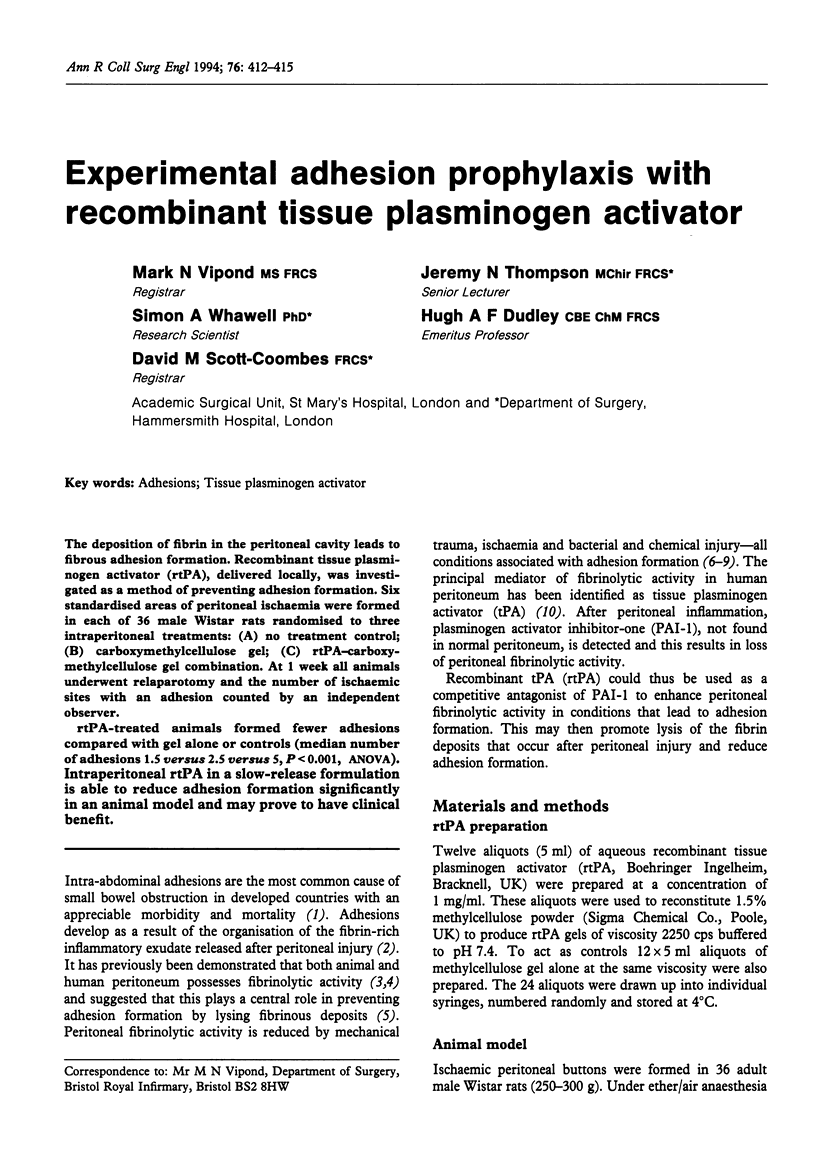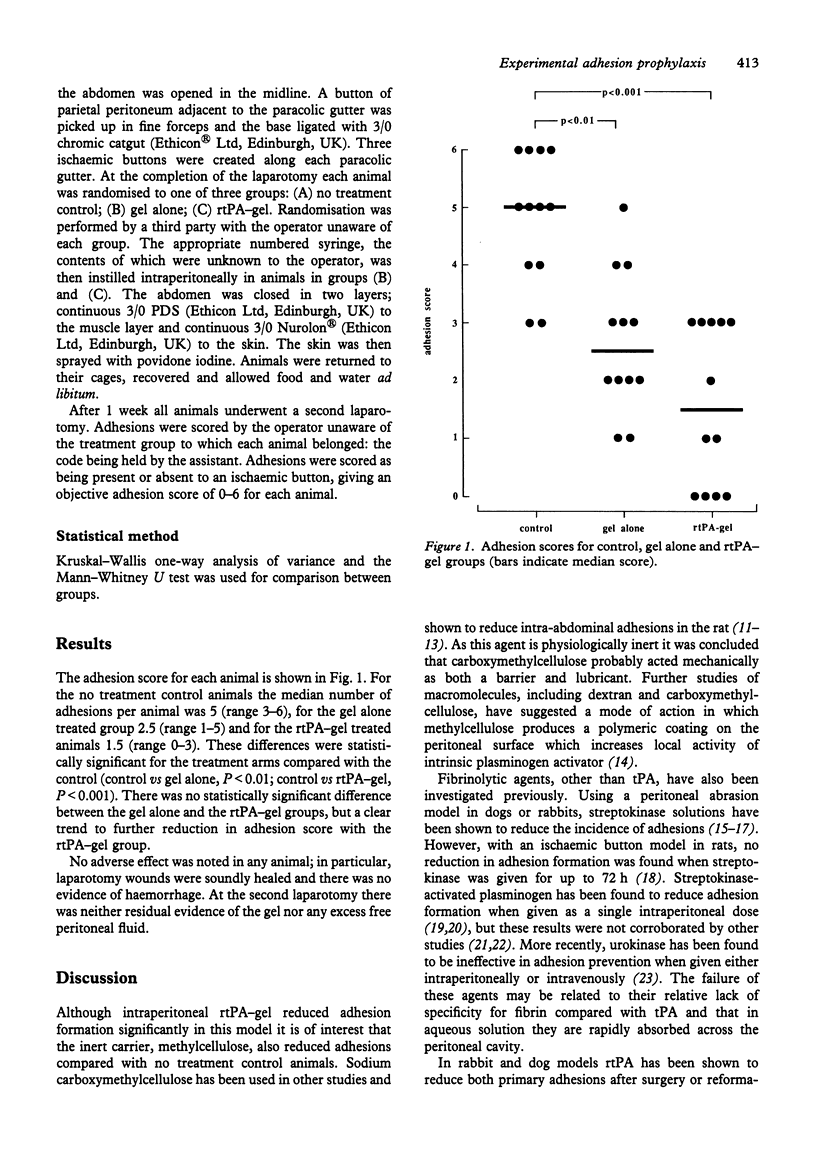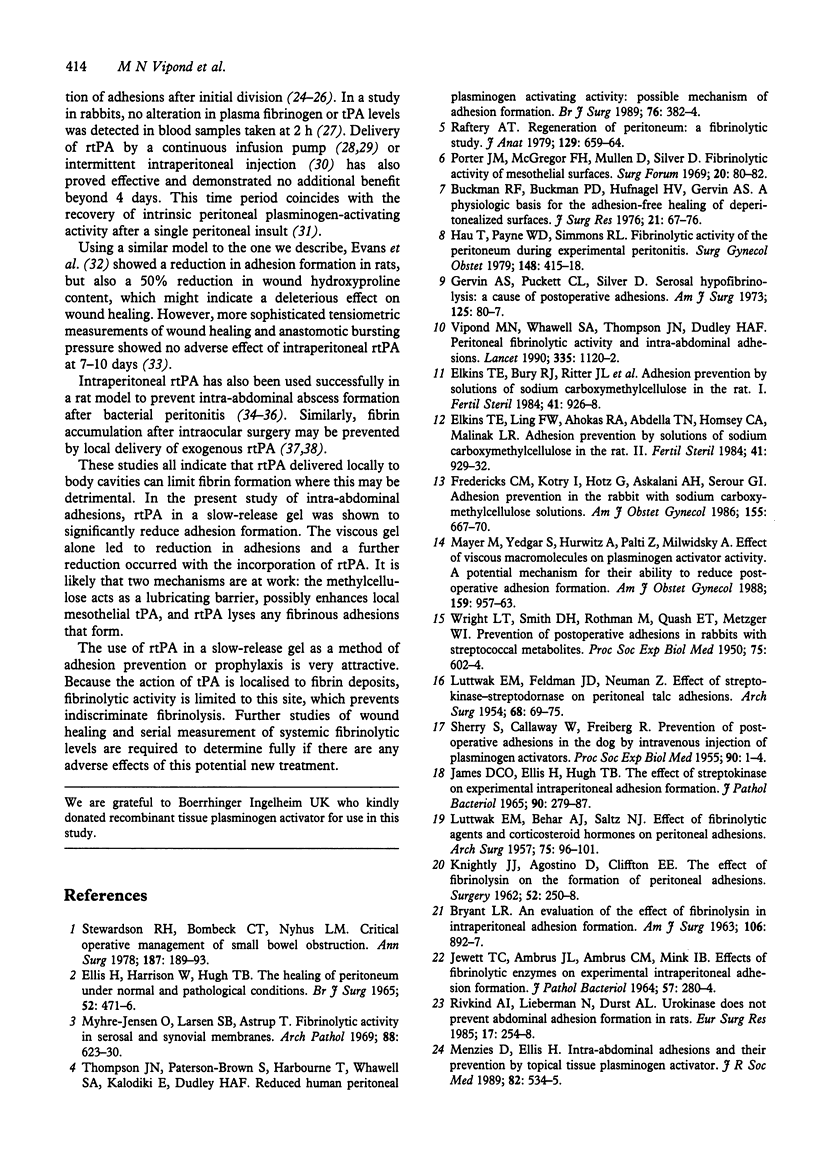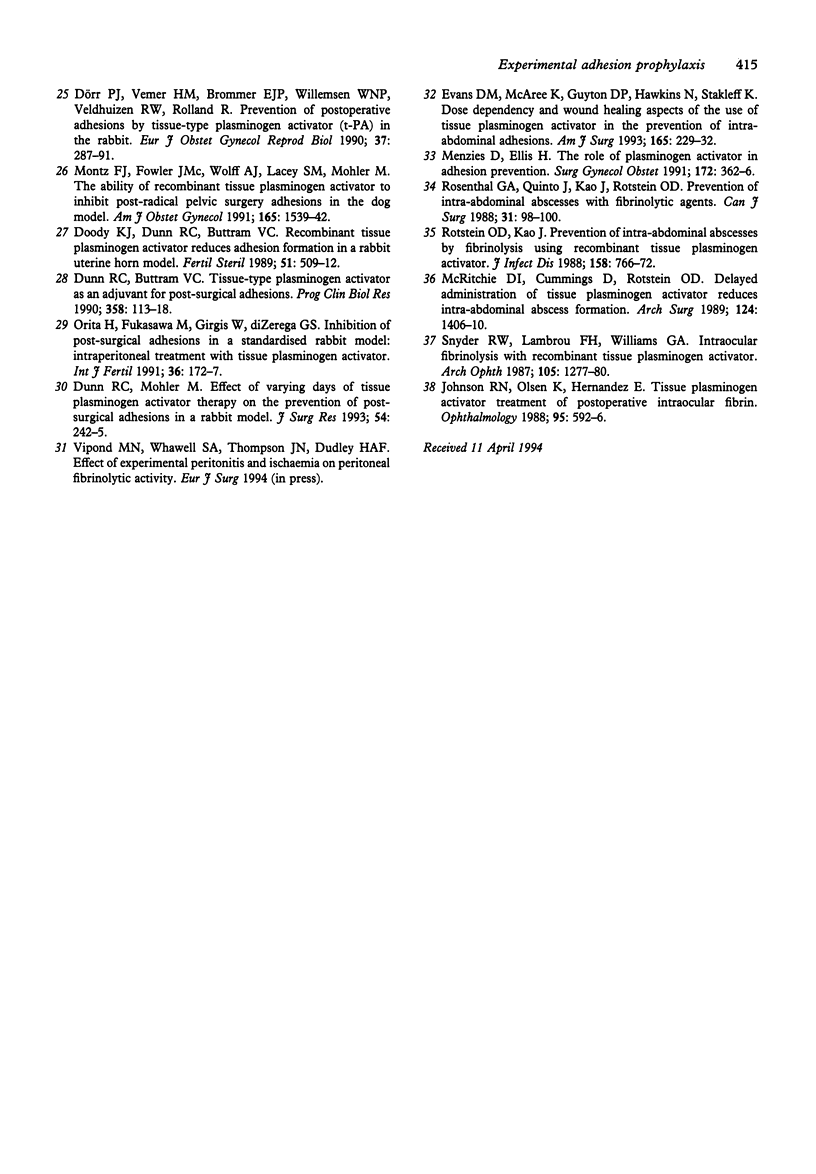Abstract
The deposition of fibrin in the peritoneal cavity leads to fibrous adhesion formation. Recombinant tissue plasminogen activator (rtPA), delivered locally, was investigated as a method of preventing adhesion formation. Six standardised areas of peritoneal ischaemia were formed in each of 36 male Wistar rats randomised to three intraperitoneal treatments: (A) no treatment control; (B) carboxymethylcellulose gel; (C) rtPA-carboxymethylcellulose gel combination. At 1 week all animals underwent relaparotomy and the number of ischaemic sites with an adhesion counted by an independent observer. rtPA-treated animals formed fewer adhesions compared with gel alone or controls (median number of adhesions 1.5 versus 2.5 versus 5, P < 0.001, ANOVA). Intraperitoneal rtPA in a slow-release formulation is able to reduce adhesion formation significantly in an animal model and may prove to have clinical benefit.
Full text
PDF



Selected References
These references are in PubMed. This may not be the complete list of references from this article.
- BRYANT L. R. AN EVALUATION OF THE EFFECT OF FIBRINOLYSIN ON INTRAPERITONEAL ADHESION FORMATION. Am J Surg. 1963 Dec;106:892–897. doi: 10.1016/0002-9610(63)90152-1. [DOI] [PubMed] [Google Scholar]
- Buckman R. F., Jr, Buckman P. D., Hufnagel H. V., Gervin A. S. A physiologic basis for the adhesion-free healing of deperitonealized surfaces. J Surg Res. 1976 Aug;21(2):67–76. doi: 10.1016/0022-4804(76)90064-0. [DOI] [PubMed] [Google Scholar]
- Doody K. J., Dunn R. C., Buttram V. C., Jr Recombinant tissue plasminogen activator reduces adhesion formation in a rabbit uterine horn model. Fertil Steril. 1989 Mar;51(3):509–512. doi: 10.1016/s0015-0282(16)60563-0. [DOI] [PubMed] [Google Scholar]
- Dunn R. C., Buttram V. C., Jr Tissue-type plasminogen activator as an adjuvant for post surgical adhesions. Prog Clin Biol Res. 1990;358:113–118. [PubMed] [Google Scholar]
- Dunn R. C., Mohler M. Effect of varying days of tissue plasminogen activator therapy on the prevention of postsurgical adhesions in a rabbit model. J Surg Res. 1993 Mar;54(3):242–245. doi: 10.1006/jsre.1993.1038. [DOI] [PubMed] [Google Scholar]
- Dörr P. J., Vemer H. M., Brommer E. J., Willemsen W. N., Veldhuizen R. W., Rolland R. Prevention of postoperative adhesions by tissue-type plasminogen activator (t-PA) in the rabbit. Eur J Obstet Gynecol Reprod Biol. 1990 Dec;37(3):287–291. doi: 10.1016/0028-2243(90)90037-2. [DOI] [PubMed] [Google Scholar]
- ELLIS H., HARRISON W., HUGH T. B. THE HEALING OF PERITNEUM UNDER NORMAL AND PATHOLOGICAL CONDITIONS. Br J Surg. 1965 Jun;52:471–476. doi: 10.1002/bjs.1800520616. [DOI] [PubMed] [Google Scholar]
- Elkins T. E., Bury R. J., Ritter J. L., Ling F. W., Ahokas R. A., Homsey C. A., Malinak L. R. Adhesion prevention by solutions of sodium carboxymethylcellulose in the rat. I. Fertil Steril. 1984 Jun;41(6):926–928. doi: 10.1016/s0015-0282(16)47909-4. [DOI] [PubMed] [Google Scholar]
- Elkins T. E., Ling F. W., Ahokas R. A., Abdella T. N., Homsey C. A., Malinak L. R. Adhesion prevention by solutions of sodium carboxymethylcellulose in the rat. II. Fertil Steril. 1984 Jun;41(6):929–932. doi: 10.1016/s0015-0282(16)47910-0. [DOI] [PubMed] [Google Scholar]
- Evans D. M., McAree K., Guyton D. P., Hawkins N., Stakleff K. Dose dependency and wound healing aspects of the use of tissue plasminogen activator in the prevention of intra-abdominal adhesions. Am J Surg. 1993 Feb;165(2):229–232. doi: 10.1016/s0002-9610(05)80516-1. [DOI] [PubMed] [Google Scholar]
- Fredericks C. M., Kotry I., Holtz G., Askalani A. H., Serour G. I. Adhesion prevention in the rabbit with sodium carboxymethylcellulose solutions. Am J Obstet Gynecol. 1986 Sep;155(3):667–670. doi: 10.1016/0002-9378(86)90304-2. [DOI] [PubMed] [Google Scholar]
- Gervin A. S., Puckett C. L., Silver D. Serosal hypofibrinolysis. A cause of postoperative adhesions. Am J Surg. 1973 Jan;125(1):80–88. doi: 10.1016/0002-9610(73)90011-1. [DOI] [PubMed] [Google Scholar]
- Hau T., Payne W. D., Simmons R. L. Fibrinolytic activity of the peritoneum during experimental peritonitis. Surg Gynecol Obstet. 1979 Mar;148(3):415–418. [PubMed] [Google Scholar]
- James D. C., Ellis H., Hugh T. B. The effect of streptokinase on experimental intraperitoneal adhesion formation. J Pathol Bacteriol. 1965 Jul;90(1):279–287. doi: 10.1002/path.1700900132. [DOI] [PubMed] [Google Scholar]
- Johnson R. N., Olsen K., Hernandez E. Tissue plasminogen activator treatment of postoperative intraocular fibrin. Ophthalmology. 1988 May;95(5):592–596. doi: 10.1016/s0161-6420(88)33140-4. [DOI] [PubMed] [Google Scholar]
- KNIGHTLY J. J., AGOSTINO D., CLIFFTON E. E. The effect of fibrinolysin and heparin on the formation of peritoneal adhesions. Surgery. 1962 Jul;52:250–258. [PubMed] [Google Scholar]
- LUTTWAK E. M., BEHAR A. J., SALTZ N. J. Effect of fibrinolytic agents and corticosteroid hormones on peritoneal adhesions; a comparative experimental study. AMA Arch Surg. 1957 Jul;75(1):96–101. doi: 10.1001/archsurg.1957.01280130100017. [DOI] [PubMed] [Google Scholar]
- LUTTWAK E. M., FELDMAN J. D., NEUMAN Z. Effect of streptokinase-streptodornase on peritoneal talc adhesions and granulomas; experimental study. AMA Arch Surg. 1954 Jan;68(1):69–75. doi: 10.1001/archsurg.1954.01260050071009. [DOI] [PubMed] [Google Scholar]
- Mayer M., Yedgar S., Hurwitz A., Palti Z., Finzi Z., Milwidsky A. Effect of viscous macromolecules on peritoneal plasminogen activator activity: a potential mechanism for their ability to reduce postoperative adhesion formation. Am J Obstet Gynecol. 1988 Oct;159(4):957–963. doi: 10.1016/s0002-9378(88)80181-9. [DOI] [PubMed] [Google Scholar]
- McRitchie D. I., Cummings D., Rotstein O. D. Delayed administration of tissue plasminogen activator reduces intra-abdominal abscess formation. Arch Surg. 1989 Dec;124(12):1406–1410. doi: 10.1001/archsurg.1989.01410120052011. [DOI] [PubMed] [Google Scholar]
- Menzies D., Ellis H. Intra-abdominal adhesions and their prevention by topical tissue plasminogen activator. J R Soc Med. 1989 Sep;82(9):534–535. doi: 10.1177/014107688908200909. [DOI] [PMC free article] [PubMed] [Google Scholar]
- Menzies D., Ellis H. The role of plasminogen activator in adhesion prevention. Surg Gynecol Obstet. 1991 May;172(5):362–366. [PubMed] [Google Scholar]
- Montz F. J., Fowler J. M., Wolff A. J., Lacey S. M., Mohler M. The ability of recombinant tissue plasminogen activator to inhibit post-radical pelvic surgery adhesions in the dog model. Am J Obstet Gynecol. 1991 Nov;165(5 Pt 1):1539–1542. doi: 10.1016/0002-9378(91)90402-d. [DOI] [PubMed] [Google Scholar]
- Myrhe-Jensen O., Larsen S. B., Astrup T. Fibrinolytic activity in serosal and synovial membranes. Rats, guinea pigs, and rabbits. Arch Pathol. 1969 Dec;88(6):623–630. [PubMed] [Google Scholar]
- Orita H., Fukasawa M., Girgis W., diZerega G. S. Inhibition of postsurgical adhesions in a standardized rabbit model: intraperitoneal treatment with tissue plasminogen activator. Int J Fertil. 1991 May-Jun;36(3):172–177. [PubMed] [Google Scholar]
- Porter J. M., McGregor F. H., Jr, Mullen D. C., Silver D. Fibrinolytic activity of mesothelial surfaces. Surg Forum. 1969;20:80–82. [PubMed] [Google Scholar]
- Raftery A. T. Regeneration of peritoneum: a fibrinolytic study. J Anat. 1979 Oct;129(Pt 3):659–664. [PMC free article] [PubMed] [Google Scholar]
- Rivkind A. I., Lieberman N., Durst A. L. Urokinase does not prevent abdominal adhesion formation in rats. Eur Surg Res. 1985;17(4):254–258. doi: 10.1159/000128475. [DOI] [PubMed] [Google Scholar]
- Rosenthal G. A., Quinto J., Kao J., Rotstein O. D. Prevention of intra-abdominal abscesses with fibrinolytic agents. Can J Surg. 1988 Mar;31(2):98–100. [PubMed] [Google Scholar]
- Rotstein O. D., Kao J. Prevention of intra-abdominal abscesses by fibrinolysis using recombinant tissue plasminogen activator. J Infect Dis. 1988 Oct;158(4):766–772. doi: 10.1093/infdis/158.4.766. [DOI] [PubMed] [Google Scholar]
- SHERRY S., CALLAWAY D. W., FREIBERG R. Prevention of postoperative adhesions in the dog by intravenous injections of plasminogen activators. Proc Soc Exp Biol Med. 1955 Oct;90(1):1–4. doi: 10.3181/00379727-90-21921. [DOI] [PubMed] [Google Scholar]
- Snyder R. W., Lambrou F. H., Williams G. A. Intraocular fibrinolysis with recombinant human tissue plasminogen activator. Experimental treatment in a rabbit model. Arch Ophthalmol. 1987 Sep;105(9):1277–1280. doi: 10.1001/archopht.1987.01060090135044. [DOI] [PubMed] [Google Scholar]
- Stewardson R. H., Bombeck C. T., Nyhus L. M. Critical operative management of small bowel obstruction. Ann Surg. 1978 Feb;187(2):189–193. doi: 10.1097/00000658-197802000-00017. [DOI] [PMC free article] [PubMed] [Google Scholar]
- Thompson J. N., Paterson-Brown S., Harbourne T., Whawell S. A., Kalodiki E., Dudley H. A. Reduced human peritoneal plasminogen activating activity: possible mechanism of adhesion formation. Br J Surg. 1989 Apr;76(4):382–384. doi: 10.1002/bjs.1800760422. [DOI] [PubMed] [Google Scholar]
- Vipond M. N., Whawell S. A., Thompson J. N., Dudley H. A. Peritoneal fibrinolytic activity and intra-abdominal adhesions. Lancet. 1990 May 12;335(8698):1120–1122. doi: 10.1016/0140-6736(90)91125-t. [DOI] [PubMed] [Google Scholar]
- WRIGHT L. T., SMITH D. H., ROTHMAN M., QUASH E. T., METZGER W. I. Prevention of postoperative adhesions in rabbits with streptococcal metabolites. Proc Soc Exp Biol Med. 1950 Nov;75(2):602–604. doi: 10.3181/00379727-75-18278. [DOI] [PubMed] [Google Scholar]


